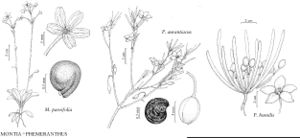Montia parvifolia
Fl. Francisc., 181. 1891.
Plants perennial, often bulbiferous, with branched caudices, mat-forming. Stems simple erect or ascending, 10–30 cm. Leaves basal and alternate, petiolate; blade oblanceolate, 10–70 × 4–12 mm. Inflorescences leafy, from apices of fertile caudex branches (determinate) or from leaf-axils of shortened fertile caudex (indeterminate), sometimes bulbiliferous in leaf-axils. Flowers 1–12, showy; sepals 2–3.5 mm; petals 5, pink or white, 6–15 mm; stamens 5, anther pink. Seeds 0.8–1.5 mm; eliaosome rounded, minute, shorter than 0.5 mm, shiny, appearing smooth. 2n = 22, 44.
Phenology: Flowering late spring-mid summer.
Habitat: Moist or wet soils and rocky cliffs of coastal and inland mountains
Elevation: 0-2800 m
Distribution

Alta., B.C., Alaska, Calif., Idaho, Mont., Nev., Oreg., Utah, Wash.
Discussion
Montia parvifolia is a variable diploid and tetraploid species. Plants with larger flowers, leaves, and seeds have been treated as var. flagellaris (Bongard) C. L. Hitchcock or as the separate species M. sweetseri Henderson. Because the complex has not been studied using modern methods, and the variation observed in herbarium specimens has no correlated geographical base, I adopt the position of K. L. Chambers (1993) and do not recognize the two above-mentioned taxa at this time. I equate the species situation here to that of M. fontana and choose not to recognize infraspecific taxa.
Selected References
None.
